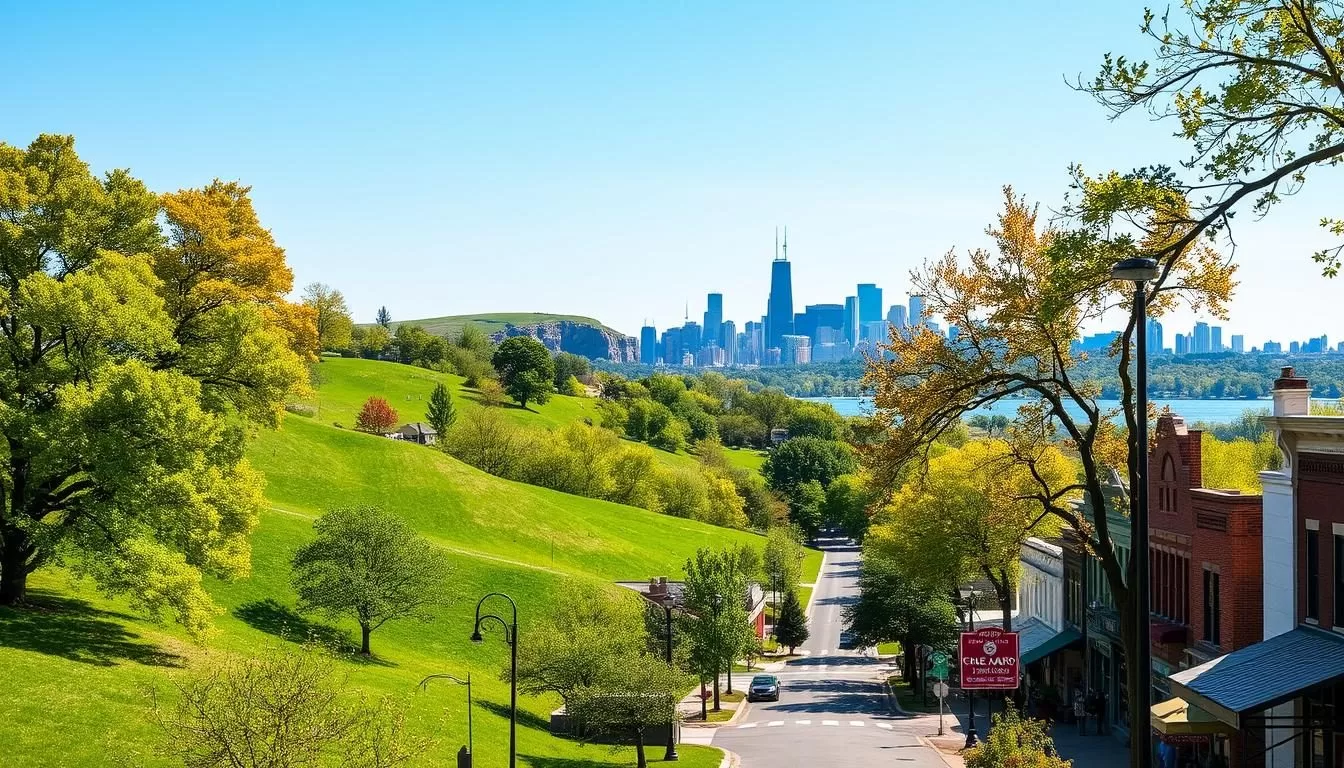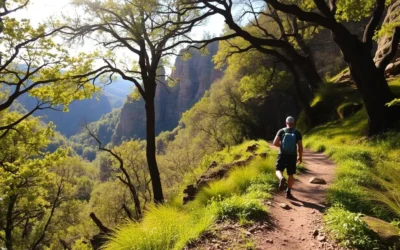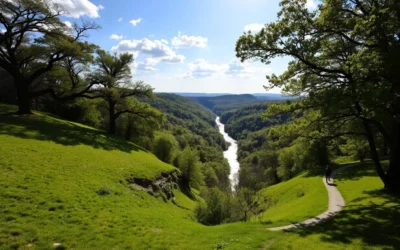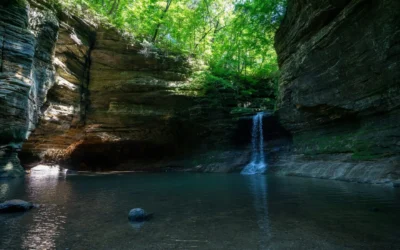✓ Accommodations✓ Flights✓ Rental Cars✓ Tours & Activities
When you’re planning a visit to Illinois, understanding the weather is crucial. The state’s diverse climate means that some times of the year are more suitable for travel than others, depending on your preferences and planned activities.
You’ll experience a range of seasonal characteristics, from humid summers to snowy winters. By understanding these patterns, you can determine the ideal time to visit based on weather conditions, crowd levels, and seasonal events. The sweet spots for travel are typically late April through June and September through early November, when temperatures are pleasant and crowds are manageable.
This guide will help you plan your trip accordingly, ensuring that you’re prepared for the weather and can make the most of your visit.
Understanding Illinois’ Climate Patterns
Understanding the climate patterns in Illinois is crucial for planning a weather-savvy trip. Illinois experiences a humid continental climate, characterized by four distinct seasons with significant temperature variations throughout the year.
The Four Distinct Seasons of Illinois
The state’s climate is marked by damp springs, hot summers, nice autumns, and cold winters. Spring in Illinois sees a lot of rain, especially in May and June, bringing mild temperatures and high humidity. Summer is hot and humid, with weather conditions often reaching the 80s and 90s Fahrenheit.
How Lake Michigan Influences Chicago’s Weather
Lake Michigan has a profound effect on Chicago’s weather, creating a microclimate that moderates temperatures along the shoreline. However, it also contributes to the “lake effect” snow in winter, making the area near the lake colder and snowier than other parts of the city.
Regional Weather Variations: Northern vs. Southern Illinois
There’s a notable difference in climate between northern and southern Illinois. The southern portion generally experiences milder winters and hotter summers than the northern part of the state, largely due to its distance from Lake Michigan and its more southerly latitude.
As you plan your trip to Illinois, understanding these seasons and regional variations will help you prepare for the weather conditions you’ll encounter.
Spring in Illinois: March to May
The arrival of spring in Illinois brings a welcome change in weather and scenery. As the state transitions from the cold winter months, the spring season unfolds with mild temperatures and blooming flora.
Weather Expectations: Temperatures and Rainfall
During spring, Illinois experiences a gradual warming trend. Temperatures gradually rise from the 40s-50s°F in March to the 60s-70s°F by May. However, weather can be unpredictable, with rainfall common throughout the season. You can expect 10-12 rainy days in April, with an average low of 39°F (4°C).
| Month | Average High Temp | Average Low Temp | Rainfall Days |
|---|---|---|---|
| March | 54°F (12°C) | 36°F (2°C) | 12 |
| April | 64°F (18°C) | 45°F (7°C) | 10-12 |
| May | 74°F (23°C) | 54°F (12°C) | 10 |
Spring Blooms and Natural Attractions
spring progresses, Illinois’ parks and gardens come alive. You can enjoy tulips along Michigan Avenue in Chicago and wildflowers in state parks and natural areas. The blooming flora creates a vibrant landscape, making it a great time to explore the outdoors.
Spring Festivals and Events Worth Attending
Illinois hosts various events and festivals during the spring. The Chicago Latino Film Festival celebrates Latin American cinema, while the Chicago Rum Festival offers a taste of Caribbean drinks. You can also attend the ChiTeen Lit Fest for young writers and book lovers. These events showcase the state’s cultural diversity and provide unique experiences.
When visiting Illinois in the spring, be prepared for unpredictable weather. Packing layers and rain gear will ensure you’re ready for any situation.
Summer in Illinois: June to August
With the arrival of summer, Illinois comes alive with outdoor concerts, festivals, and water activities along Lake Michigan. The warm weather brings out the best in the state’s natural beauty and cultural scene, making it an ideal time to explore all that Illinois has to offer.
Heat and Humidity: What to Expect
Summer in Illinois is characterized by hot and humid weather, with temperatures often reaching the low 80s to high 90s Fahrenheit (26°C to 37°C). It’s not uncommon to experience heatwaves, and sudden storms can occur, making the weather somewhat unpredictable. To make the most of your visit, it’s essential to stay hydrated, wear light, breathable clothing, and apply sun protection.
| Month | Average High Temperature (°F) | Average Precipitation (inches) |
|---|---|---|
| June | 82 | 3.8 |
| July | 86 | 3.9 |
| August | 84 | 4.2 |
Summer Festivals and Outdoor Activities
Despite the heat, summer is a peak season for outdoor events in Illinois. The state hosts numerous festivals, including the world-famous Lollapalooza music festival in Chicago, which attracts visitors from all over the globe. Other notable events include the Chicago Blues Festival, celebrating the city’s rich blues heritage, and the Taste of Chicago, showcasing the city’s diverse culinary scene.
Lake Michigan Beaches and Water Recreation
Lake Michigan’s beaches offer a refreshing escape from the summer heat. Visitors can enjoy swimming, boating, and various waterfront activities. The lake’s scenic shoreline is perfect for leisurely strolls or picnics, providing a cool respite from the summer sun.
In conclusion, summer in Illinois is a vibrant season filled with exciting events and activities. By being prepared for the heat and humidity, you can fully enjoy all that the state has to offer during this time.
Fall in Illinois: September to November
Fall is a fantastic time to experience Illinois, from its beautiful fall colors to its lively festivals. As the summer heat dissipates, the state transforms into a picturesque landscape, making it an ideal destination for travelers.
Perfect Weather and Fall Foliage
During the fall season, Illinois enjoys comfortable temperatures ranging from the 50s to 70s°F, making it perfect for outdoor activities. The fall foliage is spectacular, with peak colors usually occurring in mid-October. You can enjoy scenic drives along the Illinois River Road National Scenic Byway or hike through the Shawnee National Forest to witness the vibrant autumn colors.
| Location | Peak Foliage Time | Popular Activities |
|---|---|---|
| Northern Illinois | Late October | Hiking, Apple Picking |
| Central Illinois | Mid-October | Scenic Drives, Wine Festivals |
| Southern Illinois | Early November | Pumpkin Patches, Halloween Celebrations |
Autumn Festivals and Harvest Events
Illinois is renowned for its autumn festivals, which celebrate the harvest season. The Chicago Jazz Festival and Riot Fest are just a couple of the many events that take place during the fall. You can also visit the Green City Market in Lincoln Park, which features over 50 vendors and chef demonstrations.
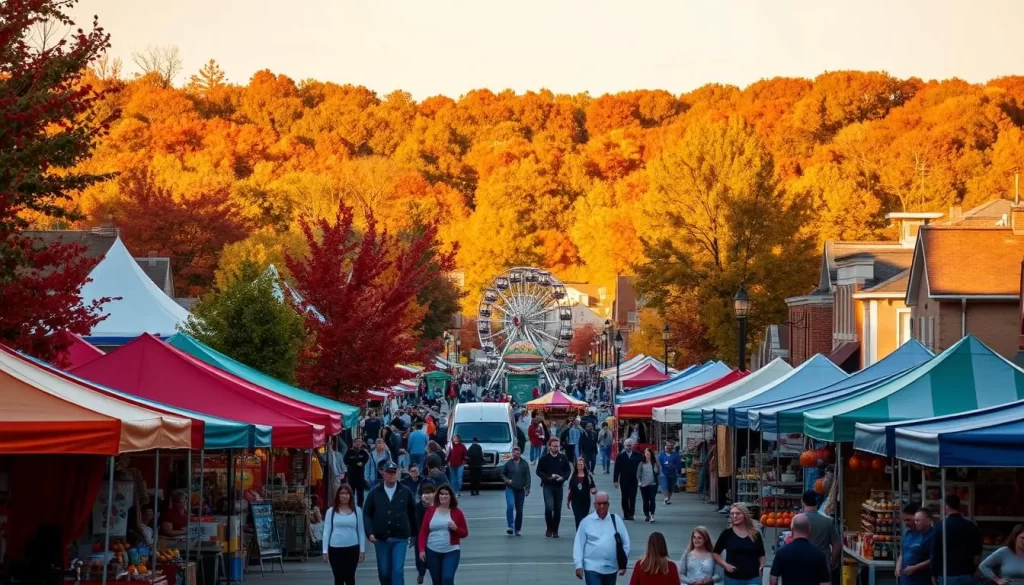
Why Fall Might Be Illinois’ Best Season
With its pleasant weather, fewer crowds, and reasonable accommodation prices, fall offers an ideal balance for travelers. Whether you’re interested in exploring the outdoors, enjoying local festivals, or simply taking in the beautiful fall foliage, Illinois in the fall has something for everyone.
Winter in Illinois: December to February
Illinois in the winter offers a unique blend of cold weather and exciting events. As you plan your trip, understanding what to expect can make a big difference.
Navigating the Cold and Snow
Illinois winters are known for their cold temperatures, often below freezing, and significant snowfall. Daytime highs in Chicago during winter are usually in the 30s°F (0-4°C), while nights can be even colder. To navigate this weather, it’s essential to dress warmly with a thick coat, gloves, and snow boots.
| City | Average High Temperature (°F) | Average Snowfall (inches) |
|---|---|---|
| Chicago | 34 | 18.3 |
| Springfield | 38 | 14.1 |
| Rockford | 32 | 22.1 |
Indoor Activities and Winter Events
Despite the cold, Illinois offers a wide range of indoor activities and winter events. You can visit the Christkindlmarket in Chicago, a traditional German-style Christmas market, or attend the Chicago Auto Show, one of the largest auto shows in North America. The state’s vibrant performing arts scene also includes world-class theaters, museums, and cultural institutions.
Winter Sports and Outdoor Recreation
For those who enjoy winter sports, Illinois provides opportunities for ice skating, sledding, cross-country skiing, and winter hiking. Many parks and outdoor spaces remain accessible during the winter months, offering a serene landscape for those who embrace the cold.
By being prepared for the weather and knowing what activities are available, you can have a fulfilling trip to Illinois even in the winter. Whether you’re interested in indoor events or outdoor adventures, there’s something for everyone.
Illinois, United States: Best Months for a Weather-Savvy Trip
When planning a trip to Illinois, timing is everything, and the state’s diverse climate means that some months are better than others for a visit. Illinois experiences a humid continental climate with distinct seasons, making it crucial to choose the right time for your travel plans.
The state offers two primary “sweet spots” for visitors: late spring to early summer and early fall. These periods are characterized by comfortable temperatures and fewer crowds, making them ideal for exploring Illinois’ many attractions.
Late April to June: The First Sweet Spot
The late spring and early summer months, from late April to June, represent the first ideal period for visiting Illinois. During this time, temperatures are warming up, landscapes are in bloom, and the crowds are still relatively manageable compared to the peak summer months. You can enjoy outdoor activities, festivals, and cultural events without the intense summer heat or the chill of winter.
- Enjoy mild temperatures and blooming landscapes.
- Experience pre-summer crowd levels, making popular destinations more accessible.
- Participate in spring festivals and outdoor activities.
September to Early November: The Second Sweet Spot
The early fall season, from September to early November, is the second optimal period for a trip to Illinois. This time is marked by comfortable temperatures, the beauty of fall foliage, and smaller tourist crowds. It’s an excellent time for outdoor adventures, visiting cultural attractions, and enjoying the local cuisine.
- Take in the beautiful fall colors and comfortable temperatures.
- Avoid the peak tourist season crowds.
- Enjoy outdoor activities and cultural events.
Weather Considerations for Different Travel Styles
Understanding the weather and its implications is crucial for planning your trip according to your travel style. Whether you’re interested in outdoor adventures, cultural experiences, family activities, or budget travel, the weather can significantly impact your plans. For instance, if you’re looking for outdoor activities, the mild weather of late spring or early fall might be ideal. Conversely, if you’re on a budget, avoiding peak season can help you save on accommodations and tourist attractions.
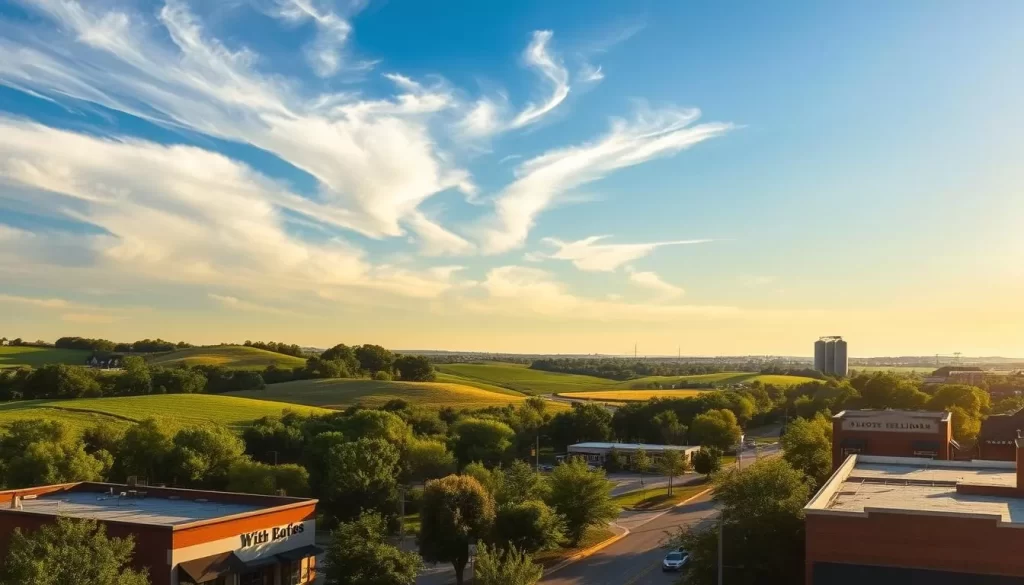
By considering the weather and choosing the right time for your visit, you can ensure a more enjoyable and stress-free trip to Illinois. Whether you’re drawn to the vibrant city life of Chicago or the natural beauty of the Illinois countryside, timing your visit correctly can make all the difference.
Month-by-Month Weather Guide for Illinois
As you plan your visit to Illinois, understanding the monthly weather patterns can help you make the most of your trip. Illinois experiences a continental climate with significant variations in weather throughout the year.
January to March: Winter into Spring
January is usually the coldest month in Chicago, with temperatures often below freezing and potential snowfall. However, in recent years, January has been more mild, with occasional days in the 40s or 50s. As February transitions into March, you can expect gradual warming and increased daylight hours.
By March, the average temperature rises, and the snow begins to melt, marking the beginning of spring. You should be prepared for unpredictable weather during this period, with average temperatures ranging from 27.7 °F in January to around 45 °F in March.
April to June: Spring into Summer
During April and May, spring blooms start to appear, and the landscape transforms with lush greenery. Temperatures continue to rise steadily, making it an ideal time for outdoor activities. June marks the beginning of summer, with temperatures often reaching the 70s and 80s.
You can expect an increase in precipitation during these months, with an average of 10-12 days of precipitation in April and May. As summer approaches, the weather becomes more humid, and the average high temperature in June is around 82 °F.
July to September: Summer into Fall
July and August are typically the hottest months, with temperatures often in the 90s. The summer heat and humidity make it essential to stay cool and hydrated during this period. As September begins, you can expect the first hints of autumn, with temperatures gradually cooling down.
The summer-to-fall transition is characterized by a decrease in humidity and the changing colors of the leaves. The average high temperature in September is around 77 °F, making it a pleasant time to visit.
October to December: Fall into Winter
October and November bring the fall foliage, with the changing leaves creating a picturesque landscape. As December approaches, the temperatures drop significantly, and the first snowfall occurs in different regions of Illinois. You should be prepared for cold weather, with average temperatures ranging from 50 °F in October to around 30 °F in December.
The fall-to-winter shift is marked by a rapid decrease in temperature and the potential for snowstorms. It’s essential to pack accordingly and stay informed about the weather conditions during this period.
Top Events and Festivals by Month
From spring to winter, Illinois hosts a wide range of exciting events and festivals that cater to diverse interests. Whether you’re visiting in the spring, summer, fall, or winter, there’s always something happening in the Prairie State.
Spring Celebrations
Spring is a vibrant season in Illinois, with events like the Chicago St. Patrick’s Day Parade and the Chicago River Dyeing in March. As the weather warms up, the city comes alive with cultural celebrations and outdoor activities.
Summer Festival Season
Summer is the peak season for festivals in Illinois. June brings the Chicago Blues Festival, while July is filled with the Taste of Chicago, Taste of River North, and the Ravinia Festival. August continues the festive atmosphere with Lollapalooza, the Chicago Jazz Festival, and the Chicago Air and Water Show.
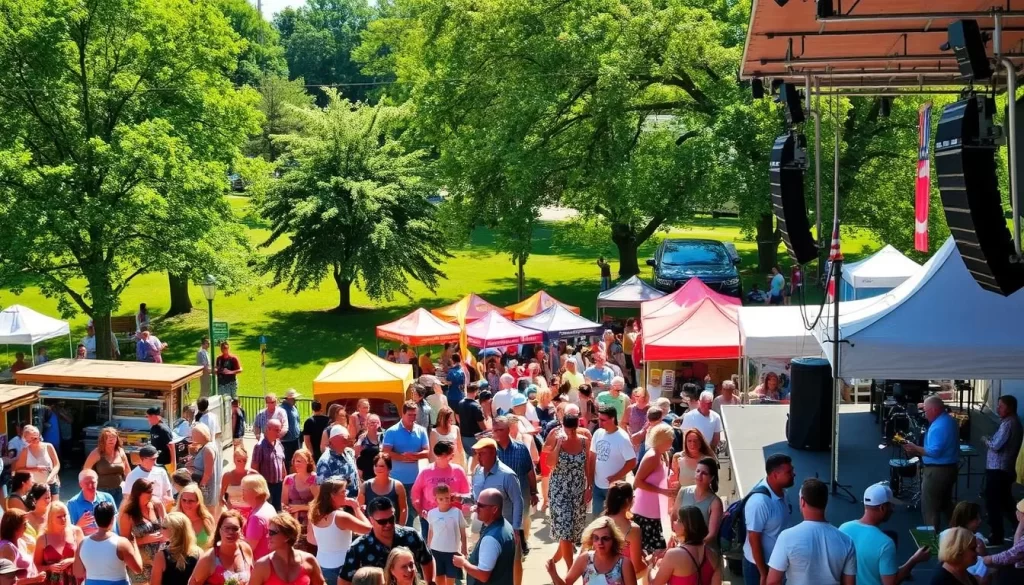
Fall Harvest and Cultural Events
As fall arrives, Illinois celebrates the harvest season with various events and festivals. October is marked by the Chicago Marathon, while November hosts the Magnificent Mile Lights Festival, a spectacular display of holiday lights.
Winter Holiday Festivities
Winter in Illinois is filled with holiday celebrations and festivities. From Christmas markets to New Year’s events, there’s a festive atmosphere throughout the state, making it a wonderful time to experience the local culture.
By planning your visit around these events and festivals, you can experience the best of Illinois, no matter the month or season you choose to visit.
Packing Tips for Different Illinois Seasons
To make the most of your visit to Illinois, it’s crucial to pack according to the season. Illinois’ diverse climate means thatpacking the right gearcan make or break your trip.
Spring Essentials: Preparing for Unpredictable Weather
Spring in Illinois can be quite unpredictable, with temperatures fluctuating significantly and frequent rainfall. It’s essential to pack layers, including lightweight jackets and waterproof gear, to be prepared for the changing weather conditions. Bringing comfortable shoes for walking and an umbrella will also enhance your spring experience in Illinois.
Summer Must-Haves: Staying Cool and Comfortable
Summer in Illinois is characterized by hot and humid temperatures, making it vital to pack light, breathable clothing such as t-shirts, shorts, and sundresses. Don’t forget to include sunscreen, sunglasses, and a hat to protect yourself from the sun. An umbrella or light rain jacket is also a good idea, as summer storms can occur suddenly.
Fall Necessities: Layering for Changing Temperatures
During the fall, Illinois experiences a significant drop in temperatures between morning and evening, making layering a crucial aspect of your packing list. Include a mix of lightweight and warmer clothing to adjust to the changing conditions. Comfortable walking shoes and a light jacket or sweater are also essentials for enjoying the fall foliage.
Winter Gear: Surviving the Illinois Cold
Winters in Illinois can be harsh, with cold and snowy conditions. To stay warm, it’s essential to pack heavy coats, gloves, scarves, and snow boots. Layering is key, as it allows you to adjust your clothing according to the indoor or outdoor weather. Thermal underwear, thick socks, and a warm hat are also vital for surviving the cold Illinois winters.
By packing according to the season, you’ll be well-prepared to enjoy all that Illinois has to offer, regardless of the time of year you visit.
Weather-Dependent Day Trips and Excursions
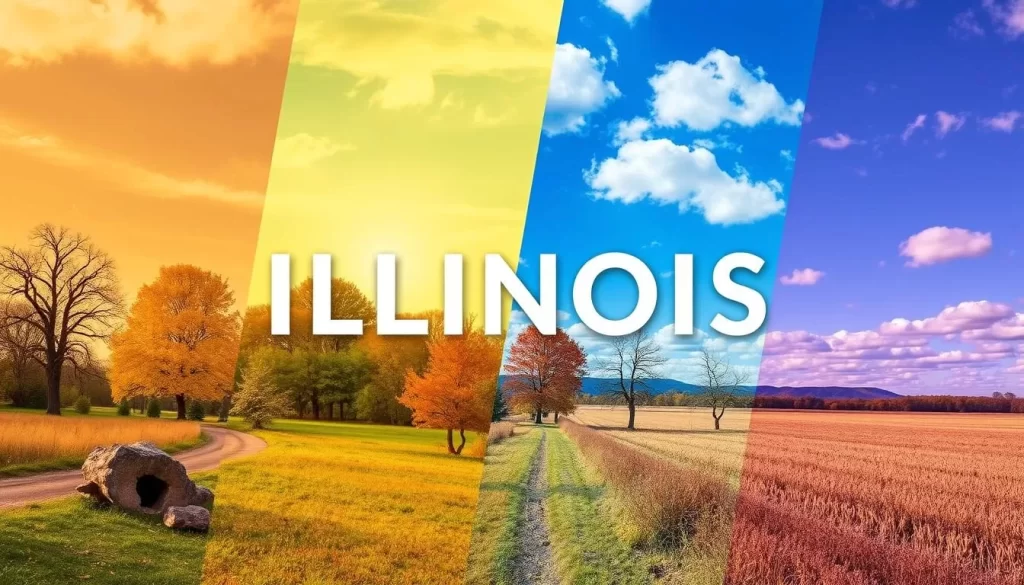
As you plan your trip to Illinois, understanding how weather impacts day trips can enhance your experience. The state’s diverse climate and seasonal changes offer a range of activities and excursions that are weather-dependent.
Scenic Drives for Fall Foliage
Illinois transforms into a kaleidoscope of colors during fall, making it an ideal time for scenic drives. The Illinois Fall Foliage Loop is a notable route that takes you through state parks and picturesque towns.
Outdoor Adventures in Pleasant Weather
Spring and summer are perfect for outdoor activities like hiking and biking. Starved Rock State Park offers trails with breathtaking views, while the Illinois River provides opportunities for kayaking and canoeing.
The pleasant weather during these seasons makes it ideal for water activities on Illinois’ numerous lakes and rivers.
Indoor Alternatives for Inclement Days
On rainy or cold days, Illinois has a wealth of indoor attractions. The Art Institute of Chicago is a world-renowned museum, while Navy Pier offers shopping and entertainment options.
These indoor activities ensure that your trip remains enjoyable regardless of the weather.
To maximize your experience, it’s essential to plan flexible itineraries that can be adjusted based on weather conditions. Monitoring forecasts and having backup plans ready will ensure that your day trips and excursions are always enjoyable.
Avoiding Crowds: Best Times for a More Relaxed Visit
To enjoy a more relaxed visit to Illinois, understanding the peak and off-peak seasons is crucial. Illinois, particularly cities like Chicago, Springfield, and Galena, attracts tourists throughout the year, but certain times are busier than others.
Peak vs. Off-Peak Seasons in Major Illinois Cities
Chicago is a popular tourist destination year-round, but it experiences peak tourism during specific periods: mid-March to mid-April for St. Patrick’s Day and spring break, summer from Memorial Day weekend to Labor Day weekend, and the holiday season from mid-November to early January. If you’re looking to avoid crowds at popular tourist attractions, consider visiting during the low season, which typically spans from mid-January through early March.
The shoulder season, which includes mid-September through early November and mid-April through mid-May, offers a good balance between manageable crowds and pleasant weather.
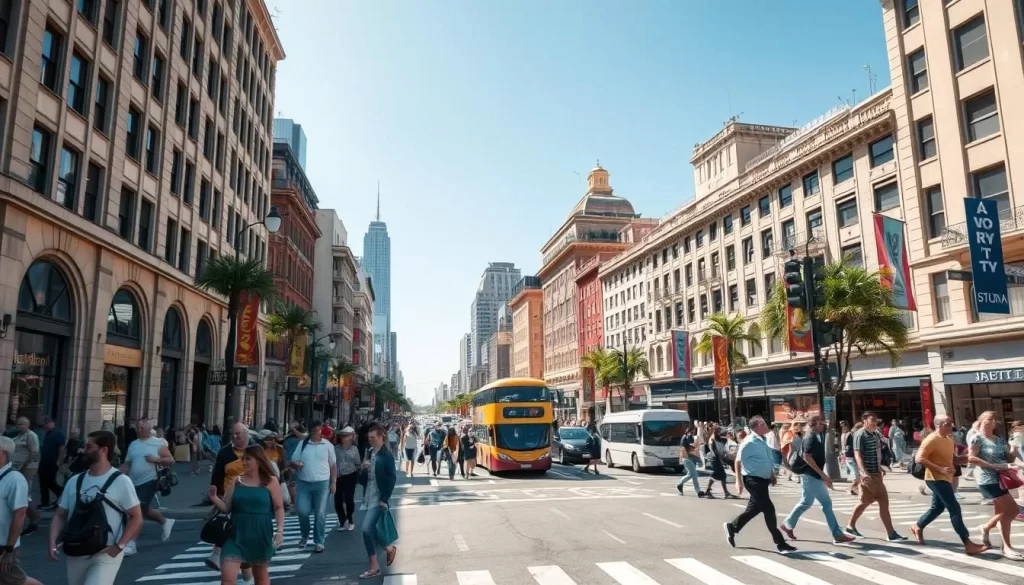
Weekday vs. Weekend Visits
Choosing to visit during the week instead of on weekends can significantly reduce the number of crowds you encounter. Many attractions and museums are less busy on weekdays, making it an ideal times visit for those who prefer a more serene experience.
Timing Your Visit to Popular Attractions
For popular attractions, consider visiting early in the morning or later in the evening to avoid the peak tourist hours. This strategy can help you have a more enjoyable and relaxed visit.
By understanding the peak season and planning your visit accordingly, you can enjoy Illinois’ attractions without the overwhelm of large crowds.
Budget Considerations Across Seasons
The cost of your Illinois trip can vary significantly depending on the time of year you choose to visit. Understanding these variations can help you plan a trip that aligns with your budget constraints.
Seasonal Price Fluctuations for Accommodations
Accommodation prices in Illinois fluctuate with the seasons. During peak travel seasons, such as summer and major holidays, hotel prices tend to be higher. Conversely, during the off-season, particularly in January, you can find lower prices on hotels due to fewer tourists.
| Season | Average Hotel Price | Tourist Demand |
|---|---|---|
| Summer (June-August) | $150-$200 per night | High |
| Winter (January) | $80-$120 per night | Low |
| Spring (April-May) | $120-$180 per night | Moderate |
| Fall (September-October) | $100-$150 per night | Moderate |
Best Value Months for Illinois Trips
For the best value, consider visiting Illinois during the shoulder season, which includes late April to June and September to early November. These periods offer a balance of decent weather, fewer crowds, and relatively lower prices for accommodations.
Saving on Activities and Attractions
To save on activities and attractions, take advantage of free museum days, discount passes, and seasonal promotions. Many attractions offer package deals that can help you stretch your travel budget further.
By understanding the seasonal fluctuations in prices and planning accordingly, you can enjoy a more budget-friendly trip to Illinois.
Planning Your Trip with Weather in Mind
To make the most of your Illinois trip, understanding the weather is key. The state’s climate can be quite varied, with sudden changes in temperature, precipitation, and wind patterns. Being prepared is essential for a comfortable and enjoyable journey.
Checking Forecasts and Weather Advisories
Before booking your trip, check the weather forecasts for your visit dates. This helps you prepare for extreme weather conditions like heavy snowfall or heatwaves. Always watch for advisories too, as they provide crucial information that could impact your plans. Keep an eye on temperature fluctuations, especially during spring and fall when the weather is less predictable.
Transportation Considerations During Different Seasons
Transportation options can vary significantly with the seasons. In winter, be prepared for potential disruptions due to snow. Summer offers more public transit options, but be aware of seasonal service changes.
Creating Flexible Itineraries for Weather Changes
Having a flexible itinerary allows you to adapt to unexpected weather changes. Include indoor backup plans for outdoor activities and understand which attractions are weather-dependent. This way, you can make the most of your trip regardless of the weather.
- Check weather forecasts before your trip to Illinois.
- Be aware of transportation changes during different seasons.
- Create a flexible itinerary to accommodate weather changes.
Conclusion
Whether you’re drawn to spring blooms or winter sports, Illinois has something for everyone, but the weather plays a significant role in shaping your trip. As we’ve explored, the state’s diverse climate means that each season offers unique experiences and attractions worth exploring.
The best time to visit Illinois depends on your preferences and plans. For most travelers, the periods from late April to June and September to early November are considered the great time to enjoy mild weather and a wide range of activities.
When planning your trip, consider your personal preferences, planned activities, and budget. Keep in mind the potential for extreme conditions in both summer and winter. By embracing Illinois’ seasonal diversity and using weather knowledge as a guide, you can enhance your travel experience rather than limiting your options.
In conclusion, Illinois is a vibrant destination that offers something for every season. With the right preparation and flexibility, you can have a memorable visit regardless of when you go.
The above is subject to change.
Check back often to TRAVEL.COM for the latest travel tips and deals.
